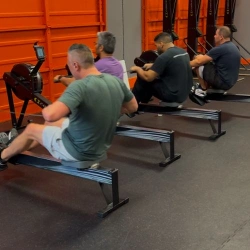

The RAMP method has been a staple in the strength and conditioning world for years, and has provided a structured framework to help exercisers and athletes prepare for training. The acronym stands for Raise, Activate, Mobilize, and Potentiate when warming up before a workout. The idea is to first raise body temperature and heart rate to prepare the cardiovascular and muscular systems, then activate key stabilizing and prime muscles, mobilize joints through controlled ranges of motion, and finally potentiate the nervous system for enhanced performance prior to the main set. It is a solid system that checks all the right boxes, especially for newer trainers learning to organize warm ups in a logical, progressive way.
Where the RAMP method shines is in its clarity. It gives coaches a mental checklist to make sure nothing is missed. Heart rate is elevated, joints are primed, stabilizers are engaged, and the body is neurologically prepared to perform. But as with many structured systems in fitness, once you move beyond the theoretical and into real world application, some adjustments are needed. In my opinion, this is where RAMP method starts to fall short.
The first issue is context. Most members at AIM Athletic do not walk into the gym as blank slates ready to perform. They come in either early in the morning after rolling out of bed or after a long day at work. The last thing I want to do is have them lie on the floor for ten minutes going through slow mobility drills or foam rolling. When someone is tired or in a low arousal state, that only makes them more tired and less ready to train. Instead, I prefer to get things going right away. That means maybe one or two dynamic movements to get the body moving, followed by a few minutes of low impact cardio on the air bike or rower to gradually raise tissue temperature and shift the body into a more alert and prepared state.
Another issue lies in the sequencing. The traditional RAMP method begins with raise, which often involves higher intensity or dynamic drills, followed by slower mobilization work. This creates an awkward flow where the warm up ramps up in intensity only to drop back down. Instead, I believe the order should better match how people naturally transition into readiness. That is why when I program workouts I have restructured it into what I call MRAP or Mobilize, Raise and then Activate and Potentiate. This small change makes a big difference in both physiological and psychological readiness.
In practice, MRAP starts with a short bout of cardio to increase tissue temperature after some specific mobilization, and is then followed by activation drills that encourage both range of motion and muscle engagement. Think bodyweight lunges, band work, and carries, all of which mimic the movement patterns of the workout itself. Finally, we move into potentiation by performing lighter sets of the main lift, progressively increasing the load until the body is fully primed for working sets. This approach builds readiness seamlessly without abrupt intensity changes or long periods of slow mobility work that disengage members mentally.
At AIM Athletic, this MRAP model has been integrated across our small group personal training, active rehabilitation, and even off season hockey programs. It respects how people actually show up to the gym, sometimes tired, stiff, or stressed, and guides them into peak readiness efficiently and effectively. I've found that with this technique our members consistently move better, perform better, and report feeling more energized heading into their main lifts, all without any increase in injury risk.
The RAMP method will always be a useful framework, especially for those learning how to structure effective warm ups. But when it comes to real world efficiency, member engagement, and performance, MRAP better matches the human experience. It is less about sticking to a model and more about understanding the body in context, something we pride ourselves on at AIM Athletic.
You've got the info now it's time to take AIM,